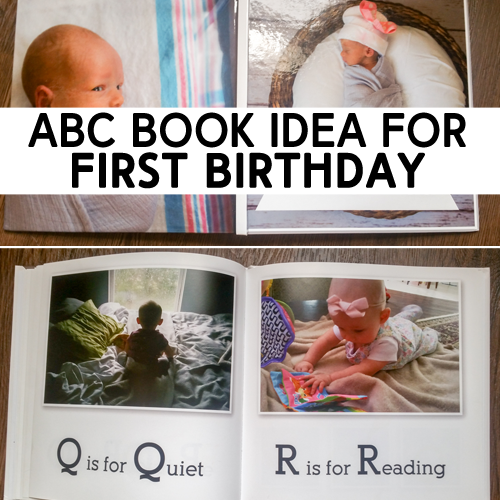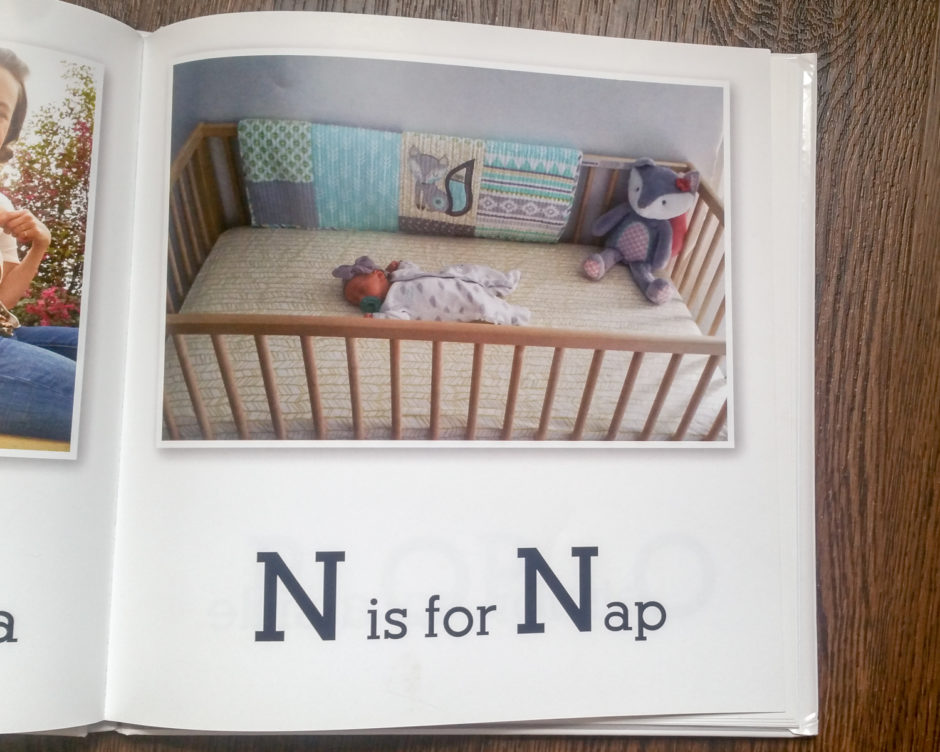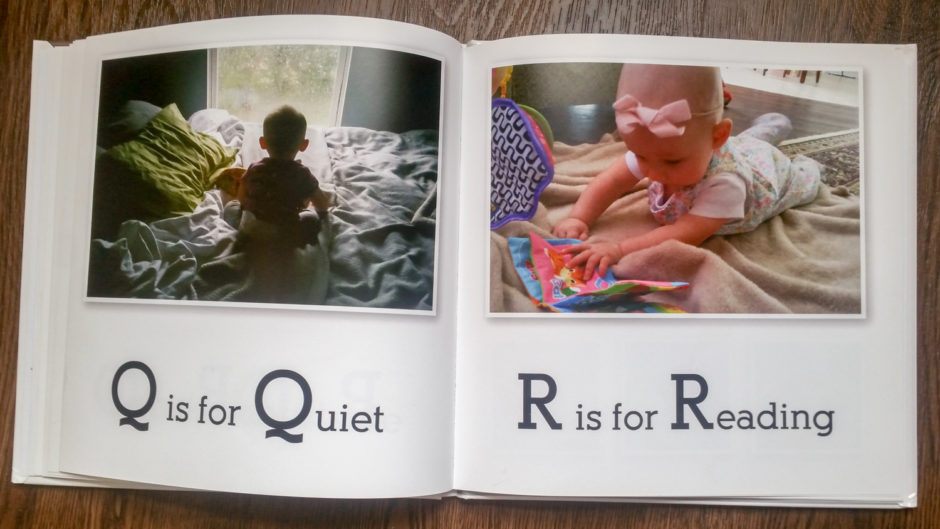In this post, you’re going to learn how to create a personalized ABC book for your child.
This DIY guide includes:
- ideas for each letter of the alphabet
- a simple process for taking, finding, and organizing children’s photos
- an easy and manageable layout for a custom ABC book
So if you want to get the PERFECT gift for your child’s birthday, you’ll love this guide.
I made my child’s custom ABC book for their first birthday, but this project is perfect for any birthday or occasion. Toddlers are learning their letters, and older children appreciate the sentiment. A personalized ABC book is a thoughtful gift for any age.
Why I Made a Custom ABC Book
For me, that first birthday stress is what motivated me to complete this project. First birthdays are extremely special. I wanted to have a memento from my little one’s party to enjoy after the party was over. I debated over other cute ideas I found. Other options I considered were an everyone loves you book, a DIY family board book, or even a commissioned cartoon book. Finally, I decided on the ABCs because it’s a classic and easy way to share many pictures. This is how I made it work.
*FTC disclosure: Some of the links in this post are affiliate links, which means I may receive a commission for purchases made through my links. All opinions remain my own.

Timeline
First, I had this book made, printed, and shipped BEFORE the party. I know what you’re thinking. I don’t have time to pre-plan like that. But, I’m someone who is a known procrastinator. This was a huge accomplishment for me. If I can do it, you can too!
Having the book physically present at my little one’s party was important. I had all the birthday guests sign and write a little message inside the front and back cover. It is something that brings a smile to my face when I see it. I know my little one will appreciate it even more when she’s older.
Creating the book took some planning, but not as much as you would think. Seriously, you can do this.
Like many parents of a little one, I already had a LOT of pictures. I started on this project about two months before my child’s birthday. I spent about a month creating the book. After that I waited a week for the book to be printed and mailed.
This book was made through MixBook. They always have great deals. I got an 8.5 x 8.5″ Glossy Hardcover and find the size perfect for reading with my little one. I paid about $30 at the time, including shipping. It takes about 11 days (using standard shipping) to receive your book, so be sure to plan in advance! (My book arrived 7 days after ordering, but the site shipping averages are longer.) I found Mixbook’s online book creator easy to use. I was very happy with the quality of the printed book.
How to Brainstorm ABC Book Letter Ideas
Brainstorming ideas for each letter for your personalized ABC book is time-consuming. So, use my tips and list to make it easier.
First, I thought about words to use based on pictures I knew I already had or could easily take. This is how I came up with simple words like B for Bath or T for Toy.
Second, I brainstormed words that focused on teaching my child. Thinking about your kid’s learning makes coming up with letter ideas easier. ABC words can be:
- Common verbs and nouns that help teach your child (eat, drink, book)
- Names of colors
- Types of animals
- Family related words (sibling names, last name, pet names)
- Favorite characters (Elmo, Daniel Tiger, Pete the Cat, Thomas the Train, you get the idea)
Using this method I jotted down a list of possible words for each letter.
Personalized ABC Book Letter Ideas
Here is my list of the word I used for each letter, along with extra ideas in parenthesis:
- A is for Applesauce (airplane, avocado, aunt)
- B is for Bellybutton (blanket, baby, bath, brother, ball, brush, bye-bye)
- C is for Cat (crawling, car, cousins, cookie, crib)
- D is for Daddy (dog, dinosaur, drawing, dancing)
- E is for Eat (exploring, eyes, elephant)
- F is for Family (frog, flower, fish)
- G is for Guitar (grandma & grandpa, go, green, giraffe)
- H is for Hat (home, hair, help, hello,hug)
- I is for Ice cream (ice, icky, inside)
- J is for Jacket (juice, jumping, jars, jam, jogging)
- K is for Kayak (kiss, kite, kicking, knocking, knot, kitchen)
- L is for Lip (lion, love, licking, light)
- M is for Mommy (mat, milk, monkey, moon)
- N is for Nap (nose, nanny, nature)
- O is for Outside (open, over, odor, ouch, okay)
- P is for Plane (playing, puppy, pushing, please)
- Q is for Quiet (quilt, quick, quack)
- R is for Reading (red, rocking, riding, robot, river, rain)
- S is for Smile (sister, swinging, sliding, shoe, sock, spaghetti, silly)
- T is for Toes (train, throwing, thinking, towel, toy)
- U is for Ukulele (uncle, underwear, unzip, upset)
- V is for Vacation (velvet, vegetable, vacuum)
- W is for Water (waving, watching, walking, wagon, window)
- X is for Xylophone (x-ray – hopefully you have no use this word!)
- Y is for Yawn (yard, yelling, yummy, yucky)
- Z is for Zoo (zebra, zero, zigzag, zipper, zombie)
Photo Organizing System
I created a folder on my computer and I began filling it with pictures I wanted to include in the book (regardless of what letter it’d go with, I just WANTED that picture!). Easy peasy. I collected about 15 photos to start with. You can find 15 photos, easy!
At this point, I began renaming each photo file with the word I thought I could use for it. Now, this is where creativity comes into play. If I had any letter duplicates, I brainstormed an alternate letter word for that picture. Let me explain.

My “N is for Nap” page is a good example of a pic I just HAD to have in the ABC book. When I looked at this pic, I could easily have included it on lots of other pages instead. It could have been “B is for Bow (or Bed)”, “C is for Crib”, “F is for Fox”, “Q is for Quilt”, or “S is for Sleep”.
For example, you can use choo-choo for train if you already have a “T”. Or, you can use water for bath if you already have “B” and need a “W” (which I did!). You get the idea.
You can also move pre-existing pictures to use with harder to find letters. I originally was going to use “yard” for my “outside” picture, but then I couldn’t find any “O” pictures. Stay with me now. It was much easier for me to find a “yawn” picture and move my “yard” picture to “outside”. (If you followed that, you’re on point. I had to reread it twice and I knew what I meant. Ha!)
At this point, you start to see what letters you are missing. Before taking new pictures, I searched for pictures on my phone. I tried to see if I already had something to match certain letters.
Stage Pictures to Fill in Missing Letters
After this process, I ended up having to take more pictures. I had no letter “x”! So I bought a xylophone second-hand just for this book…haha. Later, I let my daughter taste some “ice cream” so I’d have a letter “I” page. I did this to fill the remaining letter spots.
Staging photos at this point was easy. I only had a handful of letters that needed pictures for the book. I’m glad I didn’t start with trying to stage photos for every. single. letter. of the alphabet. It would have been too much.
Photo Layout Idea

In actually creating the book, I kept the layout simple. Most pages featured one photo with the letter text underneath. I have a tendency to go overboard, so this kept the project manageable.
Custom ABC Book Title Idea
The title of the book can be based on your child’s first name, like “B is for Brennan”. Or you can name it based on your child’s last name. You can keep it simple and name it “ABC Book for [your child’s name]”.
Wrapping it Up
This idea is really versatile and would be age-appropriate (Hello ABC’s!) for any child in Kindergarten or younger. So, don’t fret if the first birthday is already come and gone. Of course, any age can appreciate an alphabet photo book!
I already have some other books in the works, but I love new ideas. What are your tips for a personalized ABC photo book?
If you are looking for other crafty ideas, check out the learning tower we made our daughter.
